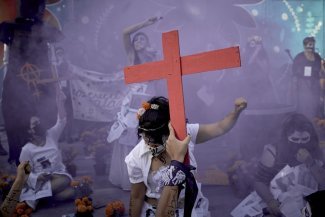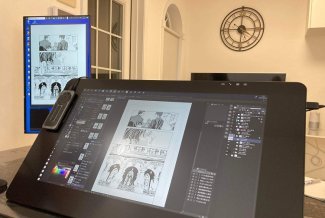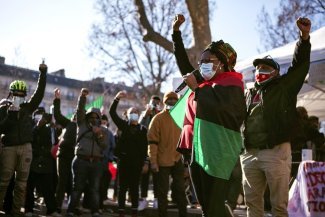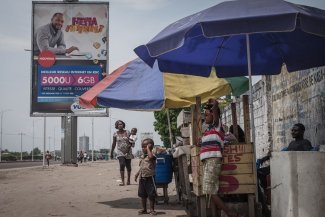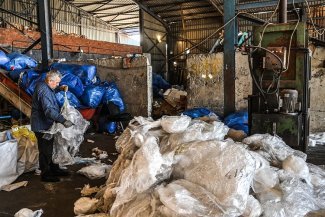A drawing made by a survivor depicts Yazidi women being sold by Da’esh. The art therapy session was organised by the Jiyan Foundation for Human Rights.
In an art therapy session for Yazidi survivors, a girl drew a portrait of her friend who committed suicide to avoid rape while under Da’esh (the so-called Islamic State, or IS) captivity. Another one drew a butterfly because her biggest wish, she explained, was to be able to fly away.
These girls are amongst the more than 6,000 Yazidis who were kidnapped from Sinjar, in northern Iraq, in August 2014. They were enslaved and transported to Da’esh prisons and homes across Iraq and Syria. Women and girls, some as young as eight, were systematically raped, beaten, burned and tortured. Brutalised by Da’esh fighters and supporters, they were treated as goods to be sold and traded, used and abused.
On 23 March 2019, Kurdish-led forces announced the defeat of Da’esh, but the extremist group’s atrocities continue to haunt the Yazidi minority displaced in Iraqi Kurdistan. Five years after the group’s onslaught, described by the United Nations as “genocide”, Yazidi survivors are still suffering from severe trauma.
“In September 2014 we heard about three Yazidi women who came back from Da’esh captivity and committed suicide,” says psychiatrist Bayan Rasul, the co-founder of the Emma Organization, a non-profit combating gender-based violence in Iraqi Kurdistan.
As Yazidi women started fleeing their captors and arriving in the Kurdistan Region of Iraq, Rasul focused all her efforts on their plight. With Emma’s co-founder Bahar Ali, she started advocating amongst governmental and religious authorities for Yazidi women to be protected, and to provide them with psychosocial support and trauma therapy.
“At that time no one had a plan to respond to the trauma. All the support was focused on relief, which was necessary, but there were no mental health programmes in Iraq. There was no psychosocial support and very few psychotherapists,” says Rasul, who specialised in treating trauma.
With mental healthcare needs far outstripping resources in Iraqi Kurdistan, organisations like Emma and the Jiyan Foundation for Human Rights have tried to fill in the gap.
Freedom tarnished by displacement and trauma
On 3 August 2014, Da’esh militants invaded the town of Sinjar, the homeland of the Yazidi minority in northern Iraq. They declared Yazidis, a Kurdish-speaking religious group, to be ‘infidels’ and ‘devil worshippers’, targeting them for murder, rape and enslavement.
More than 5,000 Yazidis, mostly men and older women, were killed and buried in mass graves in Sinjar. Young women and children were kidnapped and enslaved. Yazidi homes were looted and were temples destroyed in what has been recognised as a systematic, premeditated attempt to destroy the Yazidis of Sinjar.
Hundreds of thousands fled Sinjar and the wider region and found themselves dispersed between Syria and Iraq in August 2014. Tens of thousands of Yazidis now live in displacement camps in Iraqi Kurdistan. For those who managed to flee Da’esh captivity, freedom was tarnished by displacement and trauma.
“Now they are free they face a multitude of problems,” says Rasul. “Their houses have been destroyed, their loved ones killed, families have been scattered. They stay in refugee camps for years and there is very little the government is doing to help them return to their homes.”
The destruction of their homes, lack of security and tensions between the Iraqi federal government and the Kurdish regional government in Sinjar have prevented most Yazidis from returning to the region.
Persecuted for centuries by rulers who saw them as ‘infidels’, Yazidis sought refuge in mountainous regions in Iraq, Syria and Turkey. Before 2014, Yazidis counted 73 genocides, and stories of persecution were passed on orally from generation to generation. Long before the word genocide started to be known around the world, Yazidis already used the Ottoman Turkish word firman to describe attempts to wipe them out.
Numbering less than one million worldwide, Yazidis have been persecuted for centuries for their syncretic religious views, which incorporate elements of Zoroastrianism, Christianity and Islam. Yazidis believe in one god and worship seven angels. The Yazidism religion is spread orally and religious practice involves visiting sacred places.
Stories of killings, forced conversions and violence against the community have been passed across generations. Many Yazidis grew up carrying the burdens of historical trauma and the underlying threat of firman, which became an important part of their identity.
Collective grief, collective healing
Horrified by the crimes committed against Yazidi women, Rasul developed psychotherapy programmes to help heal individual trauma. But she soon realised that the events of August 2014 inflicted a deep, collective trauma that couldn’t be solved individually.
“The trauma was collective, so we needed collective measures to address it,” she says. “We started by asking the Ministry of Interior to protect the women and give them the status of victims of war. Then we tried to provide them with a safe space to reconnect with their faith, get some rest and calm down. We advised the Yazidi Higher Spiritual Commission to welcome the women back in Lalish.”
Lalish is the holiest place in the world for Yazidis, and they are expected to make a pilgrimage there at least once in their lives. The village is considered so sacred that visitors enter its complex of temples barefoot.
The Emma Organization worked with Yazidi activists to welcome survivors in Lalish. They prepared collective ceremonies to make survivors feel less isolated, the first step to help them reintegrate into society and begin to heal.
“We made white clothes for the women. Yazidi identity was in crisis, so the colour white is important to affirm their identity,” says Rasul. Yazidi women were given white headscarves and traditional clothes which represented purity and cleansing. The symbolic reintegration ceremonies were a response to the collective trauma, and a way to connect survivors so they could support each other.
“Collective grieving ceremonies are very important. Yazidis staying in refugee camps had no space to mourn their losses. So taking them out of the camps and hosting collective mourning sessions became very important. After the sessions I saw how they were much more hopeful,” says Rasul.
The power of art and music
Faced with the challenges of healing severe trauma and a lack of resources, therapists in Iraqi Kurdistan have begun experimenting with alternative therapies for their Yazidi patients. A programme called From Victims to Victors, an initiative of Emma Organization, is encouraging Yazidis to work on their trauma through art and music.
Holding dafs, traditional Kurdish drums, or clapping their hands enthusiastically, a group of girls sing Yazidi songs at Emma Organization’s community centre in Sharia, near the city of Dohuk.
The nearby Sharia refugee camp hosts close to 20,000 displaced people, many of them Yazidis who fled Sinjar after Da’esh’s invasion in 2014. “We heard there was a group singing Kurdish and Yazidi songs so we really wanted to join because we love music,” says 18-year-old Kathrine from Sinjar. “I want to help my community by spreading Yazidi culture.”
The girls’ music group meets every week to practice the songs and to learn how to play the Kurdish drums. The centre offers music programmes, but also literacy, handicrafts, pottery and cooking classes.
“Art and music programmes are important because they help the girls forget their problems and the trauma they experienced,” says programme coordinator Bahdinan Aassan. “Our goal is to bring the Yazidi community together so they can share experiences and emotions,” adds Aassan.
Songs of lamentation have been traditionally sung by Yazidis as a way to mourn their losses. Oral traditions are very important for Yazidis, whose songs and stories recount the trauma experienced over generations. “Music can be very therapeutic. Drumming is great to let out emotions”, says psychotherapist Rasul. “The hand drum helps survivors release anger.” The art sessions also help survivors express themselves, especially when faced with the difficulty of verbalising traumatic experiences.
“Most of them can’t read or write, so drawing is a great way to allow them to express themselves,” adds Rasul. Vocational training, literacy classes and art and music programmes keep survivors occupied and aim at encouraging them to be hopeful about their future.
“We try to talk about the future and to focus on stories of strength and success,” says human rights lawyer and Yazidi activist Hussam Abdullah. Nadia Murad, the Yazidi survivor who became a human rights activist and the 2018 Nobel Peace prize winner, is seen as an inspiration to most Yazidis.
“Her strength and power inspire many survivors who see her travelling around the world to talk about the Yazidi tragedy,” he adds.
While singing traditional songs and clapping their hands, members of the music group tell the world Yazidis have survived attempts to wipe them out. Beating their drums with their heads held high, the girls show that, like Nadia Murad, they will not be erased nor silenced. They will continue to sing and tell their stories.





